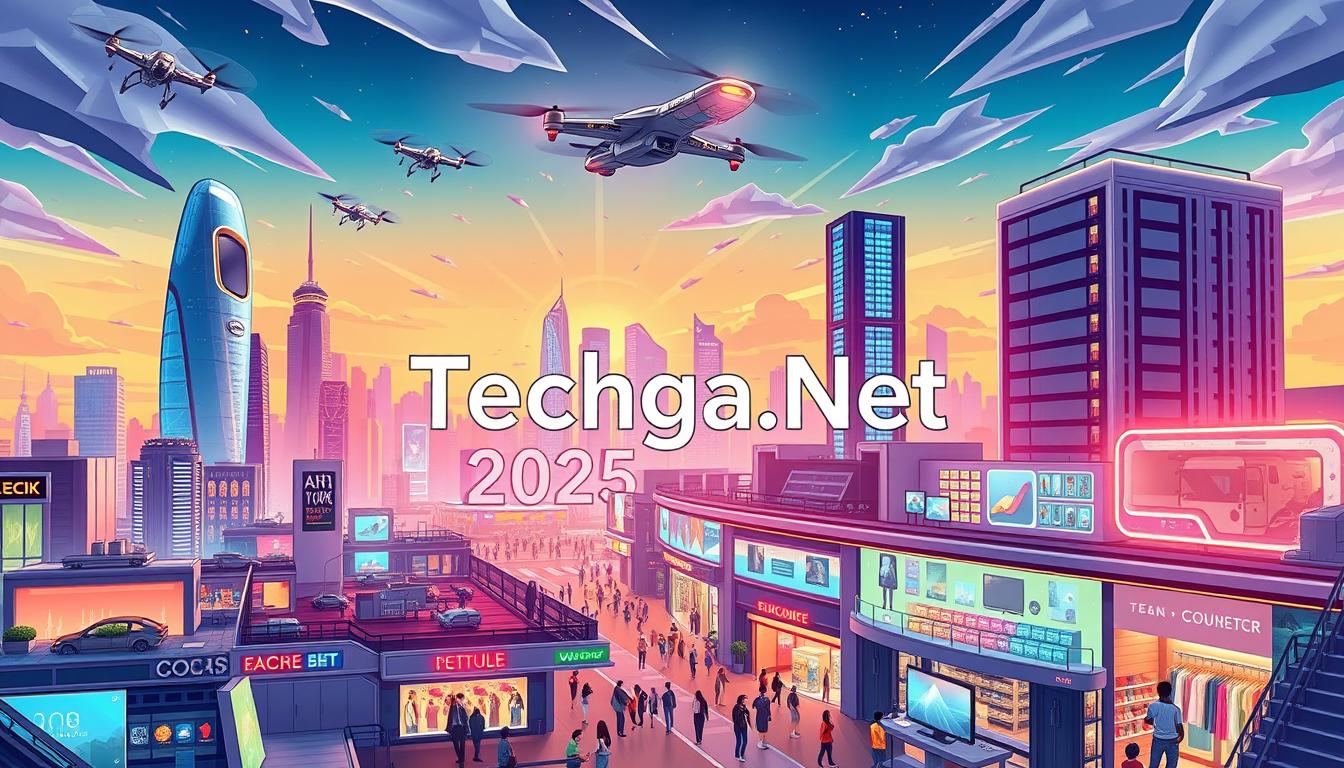The way we shop is changing fast. By 2025, ecommerce will look very different. New tools like AI, AR, and blockchain are reshaping how businesses operate and connect with customers. These technologies are not just trends; they are the foundation of the future.
Consumer behavior is evolving too. People want faster, more personalized experiences. Businesses must adapt to stay ahead. This article explores how these changes will shape the next few years. We’ll dive into the latest innovations and what they mean for your strategy.
Our insights are backed by industry reports and surveys. Together, we’ll uncover the opportunities and challenges ahead. Let’s explore the exciting journey of ecommerce and its potential for growth.
Key Takeaways
- Advanced technologies like AI and AR are transforming ecommerce.
- Consumer expectations are driving the need for personalized experiences.
- Blockchain is emerging as a key tool for secure transactions.
- Industry reports highlight significant growth opportunities.
- Businesses must adapt to stay competitive in the evolving market.
Introduction: The Future of Ecommerce in 2025
Innovation is reshaping how businesses connect with their audience. The integration of advanced tools is transforming the shopping landscape. Brands must adapt to these rapid changes to stay competitive.
Today, customers expect seamless and personalized interactions. This shift is driving businesses to rethink their strategies. The focus is now on creating engaging and tailored experiences.
One key trend is the blend of physical and digital experiences. For example, AI-powered chatbots and virtual assistants are now essential. They provide 24/7 support, enhancing the customer journey.
Here’s how brands are leveraging these innovations:
- Integrating AI for personalized recommendations.
- Using chatbots to improve online support.
- Creating immersive experiences with augmented reality.
As we move forward, the focus remains on how brands can harness these tools. The goal is to deliver exceptional experiences that drive loyalty and growth.
Exploring Ecommerce Development in 2025: Trends, Technologies, and Future Growth
The shopping landscape is undergoing a dramatic transformation. By 2025, new tools and strategies will redefine how we interact with brands. Product innovations and market expansion are interlinked with technological advancements, driving significant growth.
One key trend is the rise of personalized experiences. Consumers now expect tailored interactions, and businesses are leveraging AI to meet these demands. For example, product recommendations powered by machine learning are becoming standard. This not only enhances the shopping experience but also boosts customer loyalty.

Another major shift is the integration of digital solutions into everyday shopping. Mobile devices account for over 55% of internet traffic, making mobile commerce a critical focus. Businesses are optimizing their platforms for seamless mobile experiences, ensuring they capture this growing market.
Here’s how businesses are adapting to these changes:
- Using AI to create personalized shopping journeys.
- Expanding their reach through mobile-friendly platforms.
- Embracing emerging technologies like AR for immersive experiences.
Real-world examples highlight these strategies. Companies like BigCommerce have seen higher conversion rates by integrating diverse payment methods. This approach not only improves the customer experience but also drives growth.
The future of commerce is shaped by these innovations. As consumer behaviors evolve, businesses must stay ahead by adopting cutting-edge tools. To learn more about these trends, explore this comprehensive guide.
| Trend | Impact |
|---|---|
| Personalization | Boosts customer loyalty and satisfaction |
| Mobile Commerce | Captures over 55% of internet traffic |
| Emerging Technologies | Enhances shopping experiences with AR and AI |
Integrating Advanced Technologies in Ecommerce
Advanced tools are reshaping the shopping experience like never before. Brands are adopting cutting-edge innovations to meet rising customer expectations. These technologies are not just enhancing interactions but also redefining how businesses operate.

Artificial Intelligence Driving Personalization
Artificial intelligence is at the forefront of this transformation. Companies like Amazon use AI to analyze behavior and offer personalized recommendations. This approach ensures shoppers find what they need quickly, boosting satisfaction and loyalty.
AI-powered chatbots are another game-changer. They provide instant support, answering queries and guiding customers through their journey. This solution not only improves efficiency but also creates a seamless experience.
Augmented Reality and Blockchain for Enhanced Experience
Augmented reality is adding a new dimension to shopping. Retailers like IKEA allow users to visualize products in their homes before making an order. This immersive experience reduces uncertainty and increases confidence in purchases.
Blockchain technology is ensuring secure and transparent transactions. It minimizes fraud and builds trust by providing a clear record of every delivery. This strategy is essential for businesses aiming to protect their reputation and retain loyal customers.
Together, these innovations are creating a smarter, safer, and more engaging shopping environment. By integrating these tools, brands can stay ahead in a competitive market.
Adapting to Evolving Consumer Behavior
Consumer preferences are shifting rapidly, reshaping the way brands connect with their audience. Today, shoppers expect more than just products—they want meaningful interactions and values that align with their own. Businesses must adapt to these changes to stay relevant and build lasting relationships.
Embracing Hyper-Personalization
Hyper-personalization is no longer a luxury; it’s a necessity. Consumers want tailored recommendations and experiences that feel unique to them. Brands like Amazon are leading the way, using advanced tools to analyze behavior and deliver personalized suggestions.
This model not only enhances the shopping experience but also fosters loyalty. When customers feel understood, they’re more likely to return. Here’s how businesses can implement this approach:
- Use data to understand individual preferences.
- Offer customized product recommendations.
- Create targeted marketing campaigns.
Prioritizing Ethical Consumption
Sustainability is a growing priority for consumers, especially younger generations. Brands that demonstrate a commitment to ethical practices are gaining favor. For example, Patagonia’s focus on environmental responsibility has strengthened its reputation and customer base.
Adopting sustainable methods can set a brand apart. Here are some steps businesses can take:
- Source materials responsibly.
- Reduce waste in packaging and operations.
- Communicate sustainability efforts transparently.
| Strategy | Impact |
|---|---|
| Hyper-Personalization | Boosts customer engagement and loyalty |
| Ethical Practices | Attracts socially conscious consumers |
Embracing Omnichannel and Social Commerce
Seamless experiences across channels are becoming the new norm. Consumers no longer see a divide between online and offline shopping. Instead, they expect a unified journey that blends both worlds. This shift is driving brands to adopt omnichannel strategies that create consistency and trust.

Social media platforms like Instagram, TikTok, and Snapchat are playing a key role. These platforms are not just for engagement; they are now powerful sales drivers. Brands are leveraging these channels to reach audiences where they spend most of their time.
Unified Customer Journeys Across Channels
A unified journey ensures that every touchpoint feels connected. Whether a customer shops online, in-store, or through a mobile app, the experience should be seamless. For example, a customer might browse products on a website, check reviews on social media, and complete the purchase in a physical store.
This approach builds trust and loyalty. When customers feel understood, they are more likely to return. Brands like Nike and Sephora excel in this area, offering consistent experiences across all channels.
Leveraging Social Platforms and Influencer Collaborations
Social media is more than just a marketing tool; it’s a sales channel. Platforms like Instagram and TikTok are introducing features that make shopping easier. For instance, Instagram’s shoppable posts allow users to buy products without leaving the app.
Influencers are also transforming the way brands connect with audiences. Collaborations with influencers help brands reach niche markets authentically. For example, beauty brands often partner with influencers to showcase products in real-life scenarios.
Here’s how brands can succeed in this space:
- Integrate social media into the overall strategy.
- Collaborate with influencers who align with the brand’s values.
- Use platform-specific features to enhance the shopping experience.
| Strategy | Impact |
|---|---|
| Omnichannel Integration | Builds trust and loyalty |
| Social Commerce | Drives sales through social platforms |
| Influencer Collaborations | Reaches niche audiences authentically |
To learn more about these strategies, explore this comprehensive guide.
Transforming B2B Ecommerce Strategies
B2B strategies are undergoing a significant shift, driven by digital innovation. The focus is now on creating personalized experiences and efficient processes. This transformation is reshaping how businesses interact and conduct transactions.

Personalized storefronts are becoming the norm in B2B commerce. These platforms allow retailers to tailor their offerings to individual clients. By leveraging data, businesses can provide relevant items and services, enhancing the overall experience.
Digital marketplaces are also playing a key role. They enable self-service transactions, making it easier for clients to place purchases. This approach not only saves time but also improves efficiency for both parties.
Real-Time Insights and Tailored Experiences
Real-time insights are driving this transformation. Businesses can now track preferences and behaviors, allowing them to adapt quickly. This level of personalization fosters stronger relationships and boosts loyalty.
Here’s how these innovations are benefiting B2B strategies:
- Personalized storefronts enhance client engagement.
- Digital marketplaces streamline transactions.
- Real-time data helps businesses make informed decisions.
Integrating technology is essential for a seamless digital trade experience. For tailored digital solutions that meet your needs, explore our comprehensive services.
Expanding Cross-Border Ecommerce Opportunities
Global markets are opening doors to unprecedented opportunities for businesses. By tapping into international audiences, companies can unlock new revenue streams and build a stronger global presence. The key to success lies in understanding local preferences and adapting strategies accordingly.

Localization is essential for thriving in diverse markets. This means tailoring content, payment methods, and even product offerings to meet regional demands. For example, Alibaba has excelled by customizing its platform for different regions, ensuring a seamless experience for users worldwide.
Why Localization Matters
Adapting to local cultures and preferences builds trust and loyalty. It’s not just about translating language; it’s about understanding what drives consumer behavior in each market. This approach helps businesses connect more deeply with their audience.
Here’s how localization can drive success:
- Customizing content to resonate with local audiences.
- Offering preferred payment methods to reduce friction.
- Ensuring efficient delivery options to meet expectations.
Accessing new markets also provides valuable datum for refining strategies. By analyzing consumer behavior, businesses can make informed decisions and optimize their operations.
Developing a robust platform is crucial for overcoming challenges like regulatory compliance and logistics. With the right tools, companies can navigate these complexities and deliver exceptional experiences.
Cross-border expansion is not just a trend; it’s a strategic move for long-term growth. By embracing localization and leveraging technology, businesses can thrive in the global market.
Pioneering Sustainable and Green Commerce Practices
Sustainability is no longer just a buzzword; it’s a business imperative. Consumers are increasingly prioritizing eco-conscious choices, and brands must adapt to meet these expectations. By integrating green practices, businesses can not only reduce their environmental footprint but also build stronger connections with their audience.
Eco-Friendly Packaging and Carbon-Neutral Shipping
One of the most visible ways brands are embracing sustainability is through eco-friendly packaging. Materials like biodegradable plastics and recycled cardboard are becoming standard. These choices not only reduce waste but also resonate with environmentally conscious consumers.
Carbon-neutral shipping is another critical initiative. Companies are offsetting their emissions by investing in renewable energy projects or reforestation programs. This approach not only minimizes environmental impact but also enhances brand reputation.
Building Loyalty Through Sustainable Practices
Sustainable practices have a direct impact on customer loyalty. When consumers see a brand taking meaningful steps toward environmental responsibility, they are more likely to support it. For example, Patagonia’s commitment to sustainability has strengthened its bond with its audience.
Here’s how businesses can implement green initiatives:
- Switch to biodegradable or recyclable packaging materials.
- Partner with logistics providers that offer carbon-neutral shipping options.
- Communicate sustainability efforts transparently to build trust.
Optimizing Search with Sustainability Content
To align with consumer values, businesses must optimize their search capabilities with sustainability-focused content. This includes highlighting eco-friendly practices on websites, blogs, and social media. By doing so, brands can attract like-minded consumers and improve their visibility in search results.
For example, Allbirds, a footwear company, emphasizes its use of natural materials and carbon-neutral processes across its digital platforms. This strategy not only educates consumers but also reinforces the brand’s commitment to sustainability.
| Initiative | Benefit |
|---|---|
| Eco-Friendly Packaging | Reduces waste and appeals to eco-conscious consumers |
| Carbon-Neutral Shipping | Minimizes environmental impact and enhances brand reputation |
| Sustainability Content | Improves search visibility and aligns with consumer values |
By embracing these practices, brands can lead the way in sustainable commerce while fostering deeper connections with their audience.
Navigating Regulatory and Security Challenges
The regulatory landscape is evolving rapidly, presenting new challenges for businesses. Staying compliant with privacy laws like GDPR and CCPA is no longer optional—it’s essential. At the same time, robust cybersecurity measures are critical to protect sensitive customer data and maintain trust.
Ensuring Compliance with Privacy and Tax Laws
Privacy regulations are becoming stricter worldwide. For example, GDPR requires businesses to handle customer data transparently, while CCPA gives consumers control over their information. These laws aim to protect users but also create compliance hurdles for retailers.
Tax laws add another layer of complexity. Different regions have unique requirements, making it challenging to manage cross-border transactions. Businesses must stay updated on these changes to avoid penalties and ensure smooth operations.
Implementing Robust Cybersecurity Protocols
Cybersecurity is a top priority in today’s digital world. With cyberattacks on the rise, protecting customer data is non-negotiable. Implementing advanced measures like encryption, multi-factor authentication, and regular audits can safeguard sensitive information.
Payment security is equally important. Adopting the latest payment standards, such as PCI DSS, ensures secure transactions. This not only protects customers but also builds confidence in your brand.
Here are actionable steps businesses can take:
- Stay informed about evolving privacy and tax regulations.
- Invest in advanced cybersecurity tools to protect data.
- Train employees to recognize and respond to potential threats.
- Adopt secure payment methods to enhance customer trust.
By addressing these challenges proactively, businesses can navigate the regulatory landscape effectively. A strong strategy ensures compliance, protects customer data, and fosters long-term success.
Innovating Payment and Fulfillment Solutions
The future of transactions is being reshaped by innovative solutions. Today, businesses are adopting advanced tools to meet rising customer expectations. These innovations not only enhance the shopping experience but also streamline operations for better efficiency.
Diverse Payment Methods for Enhanced Conversion
Offering multiple payment options is crucial for reducing cart abandonment. Digital wallets like Apple Pay and PayPal have become popular choices, providing a seamless and secure way to complete transactions. Buy Now, Pay Later (BNPL) options are also gaining traction, appealing to budget-conscious shoppers.
These solutions cater to diverse preferences, ensuring every customer finds a method that suits them. By integrating these options, businesses can boost conversion rates and build loyalty.
Streamlined Fulfillment and Order Management
Efficient fulfillment processes are just as important as payment innovations. Real-time stock updates and automated order management systems ensure accuracy and speed. This reduces delays and enhances the overall shopping experience.
For example, companies like Amazon use advanced systems to track inventory and manage deliveries. This approach not only improves efficiency but also strengthens customer trust.
Integrating the right platform capabilities is essential for managing these processes. A robust system ensures smooth operations, from payment to delivery, creating a seamless journey for shoppers.
Conclusion
The landscape of online transactions is evolving at an unprecedented pace. Advanced tools like AI and AR are reshaping how businesses connect with their customers. Omnichannel strategies and sustainability practices are no longer optional—they are essential for success.
To stay competitive, businesses must embrace innovation and adaptability. Leveraging data-driven insights helps in understanding customer behavior and optimizing search strategies. This approach ensures a seamless experience from browsing to order fulfillment.
As we move forward, integrating these practices will drive growth and build trust. Investing in expert eCommerce website design and development ensures a platform that meets both brand and audience needs. Continuous improvement is key to thriving in this dynamic environment.
By focusing on innovation and leveraging media effectively, businesses can unlock new opportunities. The future of commerce lies in creating meaningful, personalized experiences that resonate with consumers.



